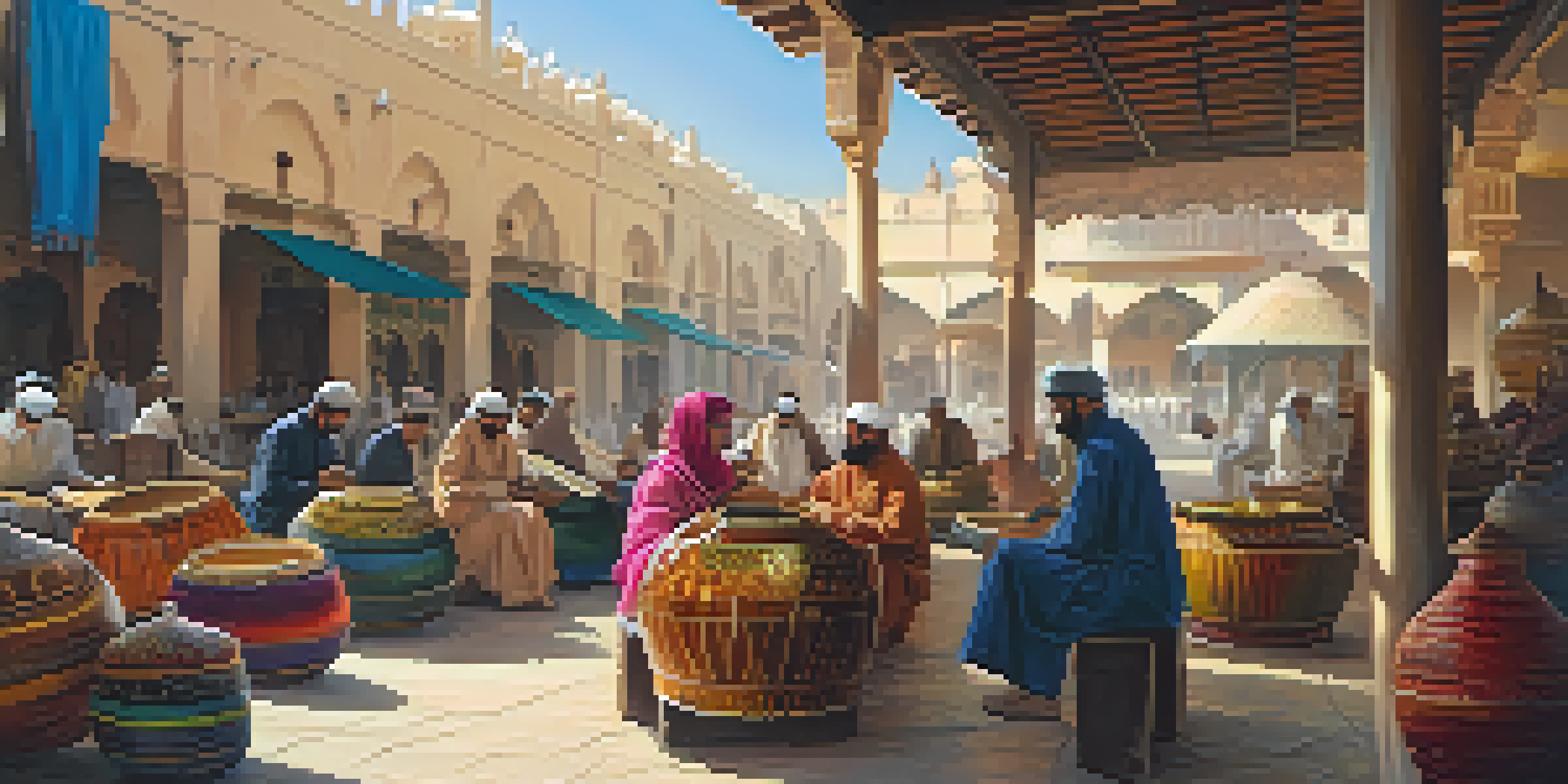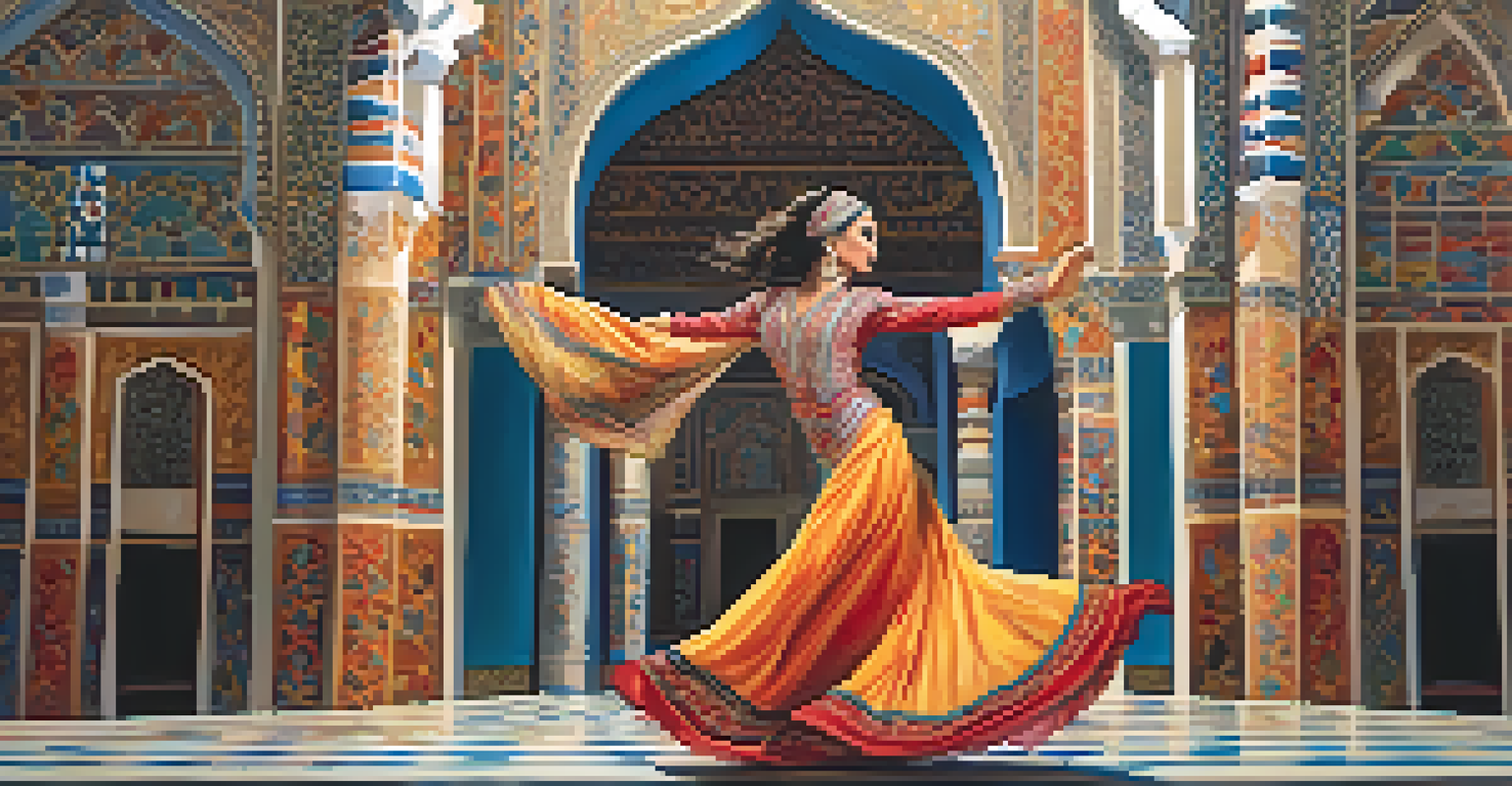Exploring the Melodies of the Middle East: A Cultural Dive

The Rich Tapestry of Middle Eastern Music
Middle Eastern music is a vibrant tapestry woven from various cultures, languages, and histories. Each country in the region has its unique sound, often influenced by its diverse ethnic groups and historical events. For instance, the haunting melodies of Arabic music can be traced back to ancient civilizations, while modern influences have integrated styles from across the globe.
Music can change the world because it can change people.
Instruments play a crucial role in this musical diversity, with traditional instruments like the oud, qanun, and darbuka bringing distinct flavors to the soundscape. The oud, a pear-shaped string instrument, is often considered the king of Middle Eastern music, resonating with deep and emotive tones. When you listen closely, you can hear the echoes of ancient stories and the rhythms of daily life in every note.
Furthermore, Middle Eastern music is deeply connected to the region's cultural practices and celebrations. From weddings to religious ceremonies, music is an essential part of communal life, uniting people through shared experiences and emotions. This interconnectedness of music and culture makes exploring the melodies of the Middle East an enriching experience.
Understanding the Maqam System
The maqam system is the backbone of Middle Eastern music theory, much like how scales operate in Western music. A maqam consists of a specific set of notes and intervals, creating a distinct emotional palette. Musicians can express a wide range of feelings, from joy to melancholy, through the careful selection and combination of these notes.

Unlike the Western music scale, which follows a fixed pattern, the maqam allows for microtones—notes that fall between the conventional semitones. This flexibility gives Middle Eastern music its unique sound, providing a rich emotional depth that resonates with listeners. Imagine how a slight bend in a note can evoke nostalgia or longing; that's the power of maqam.
Diverse Influences Shape Music
Middle Eastern music is a rich blend of various cultural influences, showcasing unique sounds from different regions.
Learning to play within the maqam system can be a transformative journey for musicians, as it challenges them to think beyond the standard notes. It encourages improvisation, allowing artists to express their individuality while staying rooted in tradition. This blend of structure and freedom is what makes the music so captivating.
The Role of Improvisation in Performances
Improvisation, or 'taqsim,' is a cornerstone of Middle Eastern musical performances, where musicians often showcase their creativity and skill. During a taqsim, musicians take turns improvising, responding to each other and the emotional energy of the audience. It's a dynamic interaction that transforms each performance into a unique experience.
The beauty of music is that it transcends language and culture, uniting us in a shared experience.
This emphasis on improvisation creates a sense of spontaneity, allowing musicians to adapt their playing to the mood of the moment. For example, at a lively wedding, the rhythms might intensify, encouraging dancers to join in, while a more somber setting might lead to slower, more contemplative melodies. This adaptability is what keeps the music fresh and engaging.
Listeners are not just passive observers; they become part of the musical dialogue. This connection between the performer and the audience enhances the overall experience, creating a shared emotional journey that transcends language and cultural barriers. It's this communal aspect of improvisation that makes Middle Eastern music so special.
Exploring Regional Variations in Music
The Middle East is not a monolith; it is a region rich in cultural diversity, and this is reflected in its music. Each country boasts its own musical styles, rhythms, and traditions. For instance, the upbeat rhythms of Levantine folk music differ greatly from the soulful melodies of Persian classical music.
In Turkey, the traditional 'Türkü' songs tell stories of love and loss, while in Egypt, the 'Maqsoum' rhythm drives the energy of popular music. Even within a single country, regional variations can be found, showcasing local dialects and instruments. This regionalism is part of what keeps Middle Eastern music vibrant and ever-evolving.
Maqam Adds Emotional Depth
The maqam system allows for microtones and emotional expression, setting Middle Eastern music apart from Western traditions.
As you explore these regional sounds, you'll find that each style carries its history and cultural significance. Understanding these differences not only enriches your appreciation of the music but also deepens your connection to the diverse communities that create it. It's a journey of discovery that reveals the heart of the Middle East.
Influence of Western Music on Middle Eastern Sounds
Globalization has opened doors for musical exchange, and Western music has significantly influenced Middle Eastern sounds. Genres like jazz, rock, and pop have found their way into the region, often blended with traditional elements to create new and exciting styles. For example, contemporary Arabic pop music incorporates catchy Western melodies with traditional rhythms, appealing to younger audiences.
Artists like Lebanese singer Fairuz and Egyptian star Amr Diab have successfully merged Western influences with their cultural roots, creating music that resonates across borders. This fusion not only broadens the appeal of Middle Eastern music but also highlights the adaptability and creativity of its artists. It's a testament to how music can bridge cultural divides.
However, this blending of sounds also raises questions about cultural identity and authenticity. As artists navigate these influences, they strive to maintain their heritage while embracing new trends. This delicate balance is part of the ongoing evolution of Middle Eastern music, ensuring it remains relevant in a rapidly changing world.
The Connection Between Music and Dance
In the Middle East, music and dance are inseparable companions, often coming together to create a vibrant cultural experience. Traditional dances like the belly dance, folk dances, and the whirling dervishes are all expressions of music that bring communities together. The rhythms of the music inspire the movement, creating a visual spectacle that captivates audiences.
Each dance style tells a story and carries its own cultural significance. For example, belly dancing, often associated with femininity and celebration, showcases the dancer's skill and connection to the music. In contrast, folk dances may represent communal gatherings and shared traditions, drawing people together in celebration.
Preserving Heritage Amid Change
Modern musicians strive to balance traditional sounds with contemporary influences to preserve their musical heritage.
This synergy between music and dance enhances the emotional impact of both forms of art. When you see a dancer moving to the rhythm of the music, you can feel the heart of the culture pulsating through every step and every note. It's a reminder of how interconnected these art forms are, enriching the cultural landscape of the Middle East.
Preserving Musical Heritage in Modern Times
As the world becomes more interconnected, the challenge of preserving musical heritage grows. Many Middle Eastern musicians are dedicated to keeping traditional sounds alive while also embracing modernity. Initiatives like workshops, festivals, and educational programs aim to teach younger generations about their musical roots.
Technology has also played a role in preserving and promoting Middle Eastern music. With platforms like YouTube and music streaming services, artists can share their work with a global audience, ensuring that traditional sounds reach new listeners. This digital age provides opportunities for collaboration that were previously unimaginable.

However, the balance between tradition and modernity is delicate. Artists must navigate the pressures of commercial success while staying true to their roots. This ongoing effort to preserve musical heritage amid the evolving landscape is vital for the cultural identity of the Middle East, ensuring that its rich musical traditions continue to thrive.